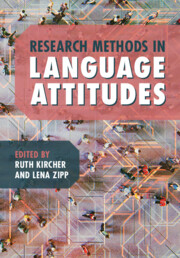Book contents
- Research Methods in Language Attitudes
- Research Methods in Language Attitudes
- Copyright page
- Contents
- Figures
- Tables
- Contributors
- Foreword
- Acknowledgements
- 1 An Introduction to Language Attitudes Research
- Part 1 Analysis of the Societal Treatment of Language
- Part 2 Direct Methods of Attitude Elicitation
- 7 Semi-Structured Interviews
- 8 Focus Groups
- 9 Questionnaires to Elicit Quantitative Data
- 10 Questionnaires to Elicit Qualitative Data
- 11 Perceptual Dialectology
- Part 3 Indirect Methods of Attitude Elicitation
- Part 4 Overarching Issues in Language Attitudes Research
- References
- Index
- References
9 - Questionnaires to Elicit Quantitative Data
from Part 2 - Direct Methods of Attitude Elicitation
Published online by Cambridge University Press: 25 June 2022
- Research Methods in Language Attitudes
- Research Methods in Language Attitudes
- Copyright page
- Contents
- Figures
- Tables
- Contributors
- Foreword
- Acknowledgements
- 1 An Introduction to Language Attitudes Research
- Part 1 Analysis of the Societal Treatment of Language
- Part 2 Direct Methods of Attitude Elicitation
- 7 Semi-Structured Interviews
- 8 Focus Groups
- 9 Questionnaires to Elicit Quantitative Data
- 10 Questionnaires to Elicit Qualitative Data
- 11 Perceptual Dialectology
- Part 3 Indirect Methods of Attitude Elicitation
- Part 4 Overarching Issues in Language Attitudes Research
- References
- Index
- References
Summary
The questionnaire, one of the most frequently used methods in the study of language attitudes, can be used to elicit both qualitative and quantitative data. This chapter focuses on the questionnaire as a means of eliciting quantitative data by means of closed questions. It begins by examining the strengths of doing this (e.g. the fact that the resulting data can easily be compared and analysed across participants) as well as the limitations (e.g. the fact that issues unforeseen by the researcher usually do not come to the fore). The chapter then discusses key issues in research planning and design: for example, question types, question wording, question order, reliability and validity, and more general issues regarding questionnaire design. The chapter also considers questionnaire distribution. The exploration of data analysis and interpretation focuses on data cleaning and coding, statistical analyses, and some points of caution regarding the interpretation of findings from questionnaire-based studies. A case study of language attitudes in Quebec serves to illustrate the main points made in the chapter. The chapter concludes with further important considerations regarding the context-specificity of findings and the benefits of combining questionnaires with other methods of attitude elicitation.
Keywords
- Type
- Chapter
- Information
- Research Methods in Language Attitudes , pp. 129 - 144Publisher: Cambridge University PressPrint publication year: 2022
References
Suggested further readings
- 3
- Cited by



